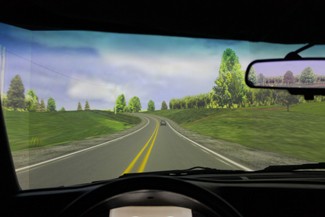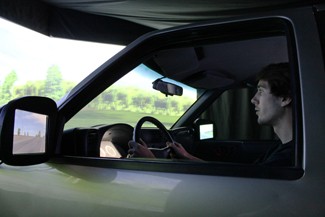UI researchers study humans and technology to solve real-world problems with simulator
Most people don’t notice IdaShields, the signs that reflect lights from an oncoming train toward a car at passive railroad crossings, but they have helped improve road safety in Idaho. The signs were invented by a University of Idaho graduate student, partially through the use of the UI driving simulator.
UI psychologist Brian Dyre works with other professors, and some students, in the Human in the Loop Simulation Lab, which provides the opportunity to study how people interact with their surroundings.

Daphne Jackson | Argonaut
The University of Idaho driving simulator is located in the Memorial Gym basement and has mulitple displays and uses the cab of a truck to make the simulation feel as real as possible.
He said one of the foremost pieces within the lab is the driving simulator, which includes seven screens — three for the front view, one for the dashboard and three for the rearview mirror images — and a computer that can be used to create a fairly realistic simulation script.
“You can essentially do anything in the simulator that you can do in the real world,” Dyre said. “In fact, some of the things we’ve done for the passing zone work, we’ve modeled actual stretches of highway in Idaho and set up the same stretch of highway in the simulator and tested it in order to compare it to the data collected in the real world.”
Dyre has spent more than 10 years studying the ways in which humans interact with technology in a specialized field known as “human factors.”
“Human factors is a combination of engineering, psychology, work physiology etcetera, and basically it’s an applied domain that seeks to understand how humans interact with their work environment,” he said. “The work environment can include things like driving. A lot of people drive for a living, but even those of us who drive just to get around, we’re still driving to our jobs and whatnot.”
One of the major ongoing projects in the driving simulator is a study of the way people pass on rural highways.
There are many two-lane highways in Idaho, and there are questions about whether these are actually safe passing zones, according to Dyre, who said highway engineers would like a more accurate way of judging whether a stretch of highway is a good place for a passing zone.
“The current guidelines for determining whether it’s a dashed line or a solid line are fairly arbitrary guidelines having to do with sight distance and things that are fairly easy to measure, but may not necessarily be the most important considerations when making these design decisions,” Dyre said. “So what we’re trying to do is provide them with a database of information on human behavior, and how humans actually use these passing zones.”
He said this project includes research from both the driving simulator and from a field researcher to ensure the results from the simulation match real-world findings.
Dyre said the driving simulator is frequently used in projects sponsored by the Idaho Transportation Department and the Alaska Department of Transportation. Some of these projects include studying the effect of a certain type of railroad signage, measuring whether different sized lane markings affect driver safety and looking at the way automated vehicle controls could impact driver safety.
Dyre said he thinks it is important to work to address problems in the Pacific Northwest because it is a chance for the university to help increase public safety.

Daphne Jackson | Argonaut
Andrew Morgan demonstrates the driving simulator April 16th in the Human in the Loop Simulation Lab.
“There’s not that many simulation facilities that have the capability we do to address some of the questions that people in the state of Alaska and the state of Idaho want,” he said. “If we can take a small amount of money, and answer some big questions that help these highway engineers design safer highways, then the states, and really the citizens of the states, can save a lot of money and a lot of heartache from unnecessary accidents.”
Dyre said although he started working with human factors in aviation, he became interested in working on surface transportation issues more than 10 years ago, so he started working with Steffen Werner, who is also a UI psychologist interested in human factors.
Werner runs several projects in the Cognition and Feasibility Lab, which focuses on aspects of how well people can use technology like website displays through the use of tools like an eye tracker, which measures where test subjects look most frequently, and therefore, what information they likely processed.
Werner said researchers in the lab are also studying ways to use passwords with pictorial elements rather than alphanumeric sequences, how to make nuclear lab displays easier to use and ways to develop an audio process to help visually impaired computer users, among other projects.
Daphne Jackson can be reached at [email protected]